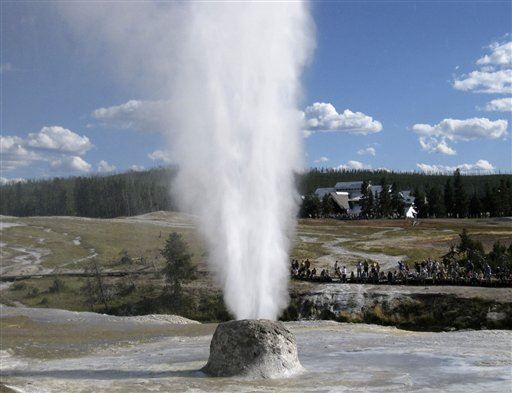Investigating The Yellowstone Magma Reservoir: Predicting Future Volcanic Behavior

Table of Contents
Geophysical Monitoring Techniques for Understanding the Yellowstone Magma Reservoir
Scientists employ a variety of sophisticated techniques to monitor the Yellowstone Magma Reservoir and glean insights into its dynamic processes. These methods provide crucial data for understanding magma movement, pressure changes, and the potential for future eruptions.
Seismic Monitoring
Seismic waves, generated by earthquakes, provide invaluable information about the subsurface structure of the Yellowstone Magma Reservoir. By analyzing earthquake frequency, location, and magnitude, scientists can map the reservoir's size, shape, and internal structures.
- Earthquake frequency and location analysis: Increased seismic activity, particularly earthquake swarms, can indicate magma movement and pressure changes within the reservoir.
- Seismic tomography: This advanced imaging technique utilizes seismic waves to create three-dimensional images of the subsurface, revealing details about the reservoir's geometry and composition. This helps identify magma pathways and potential pathways for future eruptions.
- Magnitude analysis: The magnitude of earthquakes provides insights into the stress levels within the reservoir and the potential for larger seismic events. Larger magnitude earthquakes are generally linked to greater stress and potential for magma movement. Studying the patterns of these seismic events is critical for predicting future activity. This also helps to identify areas of increased magma migration.
Ground Deformation Measurement
The surface above the Yellowstone Magma Reservoir is not static; it subtly rises and falls in response to pressure changes within the underlying magma. Ground deformation measurement techniques are essential for detecting these movements.
- GPS station data: A network of GPS stations continuously monitors ground movements with high precision, detecting even minute changes in elevation.
- InSAR satellite imagery analysis: Interferometric Synthetic Aperture Radar (InSAR) uses satellite data to measure ground deformation over large areas, providing a broader view of uplift and subsidence patterns.
- Inflation/deflation detection: Uplift (inflation) indicates magma accumulation within the reservoir, while subsidence (deflation) suggests magma release or pressure reduction. These changes are carefully correlated with seismic activity to build a more complete picture of the reservoir's dynamics.
Geochemical Analysis of Geothermal Features
Yellowstone's abundant geothermal features, including geysers and hot springs, offer a window into the processes occurring deep within the Earth. Analyzing the chemical composition of gases and water provides valuable insights.
- Gas composition analysis (CO2, SO2, He): Changes in the ratios of gases like carbon dioxide (CO2), sulfur dioxide (SO2), and helium (He) can signal changes in magma chamber processes and the potential for future eruptions. This analysis provides clues on the overall chemistry of the magma and its rate of degassing.
- Temperature and flow rate monitoring: Monitoring the temperature and flow rates of geysers and hot springs helps to track changes in hydrothermal activity, which are often linked to underlying magma movements.
- Isotopic analysis: Analyzing the isotopic ratios of elements in geothermal fluids can help determine the source and age of the fluids and provide clues about the interaction between magma and groundwater.
Modeling the Yellowstone Magma Reservoir and Predicting Eruptive Behavior
The vast amount of data gathered through geophysical and geochemical monitoring is then used to build sophisticated models of the Yellowstone Magma Reservoir.
Numerical Modeling Techniques
Computer simulations play a crucial role in understanding the complex dynamics within the Yellowstone Magma Reservoir.
- 3D modeling of the magma chamber: Sophisticated 3D models incorporate data from various sources to create a detailed representation of the reservoir's structure, temperature, and pressure.
- Simulations of different eruption styles: These models simulate different eruption scenarios, ranging from small phreatic eruptions to massive caldera-forming events.
- Probability estimations of future eruptions: By combining model outputs with probabilistic approaches, scientists can estimate the likelihood of different eruption scenarios within specific timeframes.
Probabilistic Hazard Assessment
Assessing the risk of future eruptions requires combining the outputs from numerical models with statistical analysis.
- Bayesian statistical analysis: This approach combines prior knowledge with new data to update probability estimates of future eruptions. It accounts for uncertainties inherent in the data and model limitations.
- Integration of geophysical and geochemical data: This approach involves integrating data from multiple monitoring techniques to generate a holistic picture of the reservoir's state.
- Development of eruption probability maps: These maps visually represent the spatial distribution of eruption probabilities, allowing for a better understanding of the potential impact of future volcanic activity.
Challenges and Future Directions in Yellowstone Magma Reservoir Research
Despite significant advancements, accurately predicting volcanic eruptions remains a complex challenge.
Limitations of Current Techniques
Several factors limit our ability to precisely predict volcanic eruptions at Yellowstone.
- Incomplete understanding of the magma reservoir's structure: The reservoir's exact size, shape, and internal structure are still not fully understood.
- Difficulties in interpreting geophysical data: Interpreting geophysical data can be challenging, as signals can be ambiguous and influenced by multiple factors.
- Limitations of predictive models: Current models are simplifications of a highly complex system, and uncertainties remain in their ability to accurately capture the full range of volcanic processes.
Advances in Technology and Research Methods
Ongoing research is focused on improving our understanding through technological advancements and innovative approaches.
- Advanced seismic imaging techniques: New seismic imaging methods are constantly being developed to provide higher-resolution images of the magma reservoir's structure.
- Development of more sophisticated numerical models: Researchers are working to create more realistic and comprehensive models that better account for the complexities of the system.
- Integration of diverse datasets using AI: Artificial intelligence (AI) is being increasingly used to integrate and analyze vast datasets from different sources, potentially leading to more accurate predictions.
Conclusion
Investigating the Yellowstone Magma Reservoir is a crucial endeavor for understanding and mitigating potential volcanic hazards. While accurately predicting eruptions remains a challenge, ongoing research using advanced geophysical monitoring techniques, numerical modeling, and probabilistic hazard assessment methods is continuously improving our ability to assess and understand the risks. Continued monitoring and research are paramount to improving our preparedness for potential future volcanic activity at Yellowstone. Stay informed about the Yellowstone Magma Reservoir and the latest scientific findings to better understand this powerful natural phenomenon. Learn more about predicting volcanic behavior at Yellowstone by exploring resources from the USGS and Yellowstone National Park websites. Follow the latest research on the Yellowstone Magma Reservoir to stay abreast of scientific advancements in this critical field.

Featured Posts
-
 Alien News Xenomorph Earth Threat Unveiled At Sxsw
May 27, 2025
Alien News Xenomorph Earth Threat Unveiled At Sxsw
May 27, 2025 -
 Rare Insight 1990s Rocker Addresses His Ex Wifes Maga Pop Career
May 27, 2025
Rare Insight 1990s Rocker Addresses His Ex Wifes Maga Pop Career
May 27, 2025 -
 Are Landman And Yellowstone Part Of The Same Taylor Sheridan Universe
May 27, 2025
Are Landman And Yellowstone Part Of The Same Taylor Sheridan Universe
May 27, 2025 -
 Randall And Elliot Stablers Bond Deepens In Law And Order Organized Crime Season 5 A Preview By Dean Norris
May 27, 2025
Randall And Elliot Stablers Bond Deepens In Law And Order Organized Crime Season 5 A Preview By Dean Norris
May 27, 2025 -
 Trump In Politikalari Endise Verici Gelismeler Ve Son Dakika Haberleri
May 27, 2025
Trump In Politikalari Endise Verici Gelismeler Ve Son Dakika Haberleri
May 27, 2025
